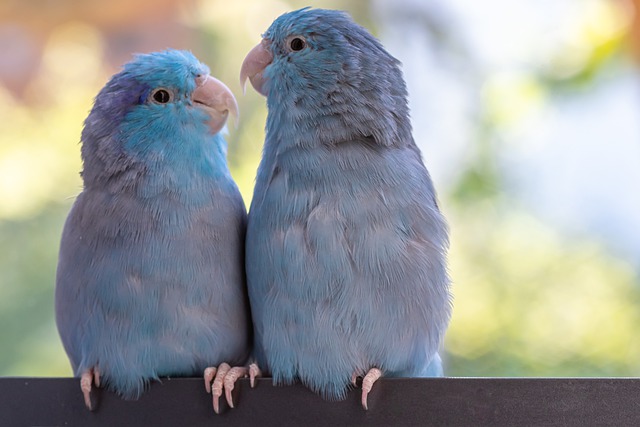Parrotlets can be found living in Central and South America with Mexico being one of their prime habitats. They will often be spotted around lowland forests to shrublands in flocks consisting of a few pairs, or as large as 100+.
Why Do Parrotlets Live In Central And South America?
Parrotlets live in Central and south America as it meets their environmental needs. Not only can these little parrots survive in wetter conditions but dry condition don’t affect their bottom line very much either.
Shrublands and lowlands forests are common in this part of the world so they can adequately camouflage effectively within their environment as well as forage for food that will satisfy their hunger. It’ll provide a number of good places to shelter within whilst the weather isn’t too hot or too cold either.
In most instances, parrots like cockatiel, parakeets or lovebirds will thrive in temperatures between 65°F and 80°F (18 – 27°C) whilst anything above 104 °F (40°C) or below 40°F (4 – 5°C) can be deadly. Central and south America are both warmer than other continents where the countries within tend to have average temperatures of around 90 – 95ºF (32 – 35ºC) throughout the day and 68º F (20ºC) at night.
The weather conditions and the multitude of locations, both dry and wet will satisfy most parrotlets basic habitual needs.
Do Parrotlets Behave Differently In The Wild?
Parrotlets will behave differently in the wild as they are tiny and the dangers present would not be as easy for them deal with unlike caged parrotlets who’s only real danger is if their owner doesn’t feed them.
Even as pets parrotlets are known to be feisty and brave, occasionally taking on a foe far bigger than them so, that is an aspect of their temperament that would likely be expanded upon in the wild. This could be when they’re fending off larger predators or if they’re in a hormonal state.
Furthermore, wild parrotlets fend for themselves as opposed to being given their necessities by an owner. Therefore, they would forage for food, whether on shrubs or on leaves, find and create shelter throughout the shrublands and forests they inhabit, communicate with others in their flock to find the best places to find food, water and so on.
They will also preen their feathers on a regular basis to make sure that not only is it shiny to attract mates but to be in good shape when flying.
Wild animals need to be more on their game in order to survive in the wild therefore, it’s only to be expected that wild parrotlets will need to be on their A game in order to survive the daily ordeals that may come their way.
Could A Caged Parrotlet Survive In The Wild?
Even though it is possible for a caged parrotlet to survive in the wild, chances still aren’t overly likely.
This is because a caged parrotlet has no experience being in the wild and fending for themselves. Even if they still have some of their natural instincts to fight and show aggression in situations that require it, their lack of experience in the field finding food or locating adequate shelter to rest in would be to their detriment.
As a result is highly likely they would either starve do death, potentially be caught by a predator, the weather may take them out or a parrotlet may even get poisoned by eating something they shouldn’t.
Furthermore, wild parrotlets tend to be a part of flocks that they can communicate with and work together to find food among other resources.
Even if a vagrant caged parrotlet were attempting to join a flock, it wouldn’t be easy for them to win this flocks favour, especially when you take into account the territorial nature of these birds
That isn’t to say that the odd few domesticated parrotlet couldn’t survive but, the odds are stacked significantly against them.
How Would A Caged And Wild Parrotlet Interact?
As wild parrotlets have dealt with the wilderness and the dangers associated with it, they may be more hostile or aggressive towards a caged Parrotlet. This would be even further amplified if say the wild parrotlet were hormonal or has had some past traumatic experiences dealing with parottlets outside their flock.
In general parrotlets are relatively social considering some join flocks that include 100+ so, it is also possible that the two may grow fond of each other willingly hang out.
However, for that bond to be built the two would need time and in some instances interventions from a third party may be needed to sperate them if any violent exchanges were to occur.
Summary
Due to a parrotlets social nature, they will flock together to go about their day, whether as a small group or as a large flock consisting of hundred of others.
They can be found in the shrublands and forests of Central and south America as the climate there fits their ideal. This is because it rarely dips below 5°C and will often remain within 20 – 35°C throughout the day and night. It also has shelter that fits a parrotlets needs and food to keep them energised throughout their day.
Amhil Khan, a dedicated nature enthusiast and the founder of BirdsOfTheWild.com, is a passionate advocate for the captivating world of avian wonders. With a deep-seated curiosity about the intricate lives of birds, Amhil’s journey began as a fascination and has evolved into a mission to inspire others to appreciate and protect these magnificent creatures.
Amhil’s love for birds led to the creation of Birds of the Wild, a platform where his expertise in ornithology, coupled with his captivating storytelling, provides readers with an immersive and educational experience. Through his lens and words, he captures the essence of birds in their natural habitats, offering a glimpse into their behaviors, migrations, and the ecosystems they inhabit.

